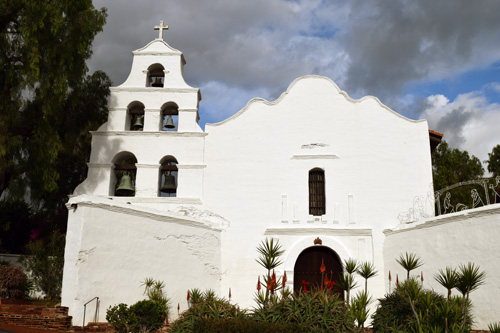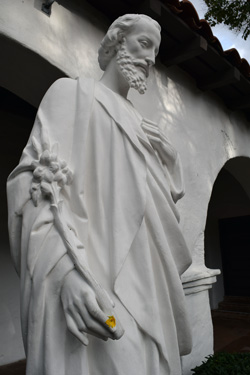
-20th in a Series-
Exit 8, Mission Gorge Road, San Diego — Mission San Diego
By Donald H. Harrison


SAN DIEGO –Under any circumstances a trip to Mission San Diego is worthwhile because it is the oldest mission in the chain that runs more than 600 miles along the coast of California and served as an instrument of this state’s European settlement. One really cannot encounter California history without knowing about Father Junipero Serra and the other Franciscan friars who taught Christianity to the indigenous people, known in this part of San Diego County as the Kumeyaay.
Mission San Diego is the inspiration for much of the nomenclature of San Diego, including the name of the neighborhood known as Mission Valley, to the names of many important streets such as Friars Road, Mission Center Road, and Mission Gorge Road, and even to the moniker of the baseball team — the San Diego Padres.
San Diego, or St. Didacus in Latin, was a lay person whose medical healing during the 16th century was thought by the King of Spain to be nothing short of miraculous. It was on his feast day in 1602 that the explorer Sebastian Vizcaino renamed the bay and its surroundings which first had been spotted and claimed by explorer Juan Rodriguez Cabrillo in 1542.
Cabrillo had named this area San Miguel, but San Diego was the official name by the time Father Serra and his party celebrated a mass atop Presidio Hill in 1769, where the mission was located for five years before being moved up-river to its present location.
One finds at Mission San Diego numerous statues and busts of many important figures in Catholic belief, but none captured my Jewish attention more firmly than that of St. Joseph, as the husband of Mary is called by Christians. He stands in a garden with his left hand held to his heart and his right hand, holding a lily, at his side. In Christian iconography, a lily represents purity.
Many Jews are familiar with the Catholic concept that Mary was a virgin impregnated by God, and that Joseph was at first suspicious of her, but was a kindly enough man that he did not intend to make a public issue of her pregnancy.
Somewhat later, according to Christian Scriptures, God’s action and plan was made known to Joseph, who thereupon performed the mitzvah of serving as Mary’s protector.
So what would have happened if Joseph had made a public issue of Mary’s pregnancy? According to Deuteronomy (or Devarim as the fifth book in Torah is known in Hebrew), if a man learns that his wife had deceived him about her virginity, then the city elders “shall take the girl to the entrance of her father’s house and the people of her city shall pelt her with stones and she shall die, for she had committed an outrage in Israel, to commit adultery in her father’s house, and you shall remove the evil from your midst.”
As Mary’s protector, and husband by law, Joseph fulfilled another important function in the interplay of Hebrew and Christian scriptures. According to Christian belief, Jesus was a direct descendant of King David. In Hebrew Scriptures, the prophet Jeremiah (23:5) predicts that “days are coming–the words of Hashem–when I will establish a righteous sprout from David; a king will reign and prosper and he will administer justice and righteousness in the land. In his days, Judah will be saved, and Israel will dwell securely.”
Christians refer to the person so described as the messiah, so it was important that Joseph, as the legal father of Jesus, was a direct descendant of King David. However, there is an apparent conflict in Christian Scriptures. The Gospel According to St. Matthew (1: 1-17) reports that Joseph was descended from David via his son King Solomon, whereas the Gospel According to Saint Luke (3:23-31) says he was a descendant of David’s son Nathan. Matthew gives the name of Joseph’s father as Jacob (thus paralleling the genealogy in Genesis), whereas Luke says Joseph was the son of Heli.
It should also be noted that in the genealogy as given by Luke, there are many more generations separating Jesus from King David than in the genealogy reported by Matthew. There is a tradition in Christianity that the genealogy recited by Luke really charts the ancestry of Mary, not Joseph, but substitutes the name Joseph because he is her husband. The importance of this interpretation is that it would mean that Jesus was descended from David biologically through his mother, and for legal purposes through his human father.
Another issue affecting Joseph–who, as bumper stickers often proclaim, was a “Jewish carpenter” — is the Catholic idea that Mary remained a virgin throughout her life. How can this be reconciled with the idea that Joseph and Mary were man and wife? According to Catholic theologians, Joseph was quite old and a widower when he married Mary, and apparently was beyond the age of sexual function. Accordingly, Joseph often is represented in Catholic iconography as an older man. Catholics consider Joseph to be both a protector of travelers and of pregnant women.
A year after San Diego’s 1769 founding, a ship bringing supplies to the mission was overdue. The military commander with whom Serra had traveled — Gaspar de Portola — feared the ship was lost and food was only sufficient for a return expedition to Baja California. To stay any longer without additional provisions risked starvation. He reportedly urged Serra to return with the soldiers to Baja California, but Serra was resolute about staying.
Instead, Serra said he would pray for nine days–an act known as a novena–to St. Joseph for the safety of the ships, and, if no ship was spotted, those in his party could leave if they wanted. On the ninth day, which happened to be St. Joseph’s feast day–March 19–a supply ship heading for Monterey Bay lost its anchor at sea and was forced to enter San Diego Bay thus saving, by chance or miracle, the expedition.
Traditionally, St. Joseph’s Day also is the day when swallows return each year to the mission at San Juan Capistrano.
This explains why the statue of St Joseph, along with those of St. Francis of Assisi — for whom the Franciscan order is named– and St. Didacus occupy special places of honor at Mission San Diego.
*
From the Mission Gorge exit, proceed east to a left turn on Twain Avenue, which will eventually become San Diego Mission Road. The mission will be on the right.
*
Next: The doctor who pioneered HMO’s
*
Harrison is editor of San Diego Jewish World. You may comment to him at donald.harrison@sdjewishworld.com
I believe that your Didacus attribution has been largely discredited by linguists. Please see this article I wrote a few years ago.
http://www.blueheronblast.com/2011/06/san-diego-de-alcala.html
–Robert Sommers, San Diego